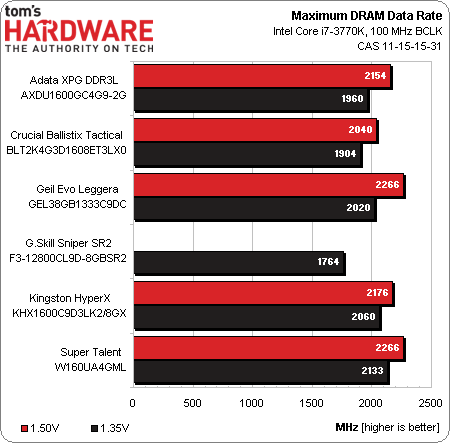Six Low-Voltage Dual-Channel 8 GB Memory Kits, Overclocked
We've abided by Intel's 1.55 V recommendation for two architectures and two die shrinks, yet most performance memory manufacturers ignore it. Recent problems with one of our builds raised the question, how far can we push RAM without killing CPUs?
Overclocking And Under-Latency Results
Though memory typically responds to added voltage by facilitating higher data rates, G.Skill’s 1.25 V Sniper SR2 topped out at 1.35 V. Unlike other modules in today’s test, 1.50 V offered G.Skill no further overclocking headroom.
Super Talent’s W160UA4GML tops the overclocking charts, though these specific modules are custom-order parts. Geil follows up with a true production product that only Europeans and Asians can purchase locally. Here in the States, look to U.S.-based firms to find memory without the distribution woes. Of these, Kingston allowed us to pick the DDR3-2133 multiplier.
The big surprise in overclocking was that Crucial’s factory-direct modules didn’t reach the same DDR3-2133 CAS 9 overclock of their retail counterparts. These kits carry the same part number, but were likely produced on different days. Better luck next time, Crucial?
| Best Stable Timings | |||
|---|---|---|---|
| Row 0 - Cell 0 | DDR3-1600 | DDR3-1866 | DDR3-2133 |
| Adata XPG DDR3L AXDU1600GC4G9-2G | 8-9-8-21 | 10-10-10-24 | 11-12-11-27 |
| Crucial Ballistix Tactical BLT2K4G3D1608ET3LX0 | 7-7-7-21 | 9-9-9-24 | Row 2 - Cell 3 |
| Geil Evo Leggera GEL38GB1333C9DC | 8-9-8-24 | 9-10-9-24 | 11-12-11-27 |
| G.Skill Sniper SR2 F3-12800CL9D-8GBSR2 | 8-8-8-21 | Row 4 - Cell 2 | Row 4 - Cell 3 |
| Kingston HyperX KHX1600C9D3LK2/8GX | 8-8-8-21 | 9-10-9-24 | 11-11-11-27 |
| Super Talent W160UA4GML | 8-9-9-24 | 10-11-10-24 | 11-13-12-31 |
Crucial does take a big lead in low-latency support, in spite of the missing DDR3-2133 data. Secondary and tertiary timings that also affect performance were left to auto-configuration values and could still play a significant role in performance tests.
Get Tom's Hardware's best news and in-depth reviews, straight to your inbox.
Current page: Overclocking And Under-Latency Results
Prev Page Test Settings Next Page Results: SiSoftware Sandra-
excella1221 Nice article.Reply
A bit surprised that Corsair Vengeance didn't make an appearance though.
Been using G.Skill RAMs since I can remember, and they've never failed me! -
DarkSable Very interesting read, thanks Tom's! Guess we've been bothering you enough about, erm, "half-height" overclocker's ram enough for you to want to do an article on it. Shame that the mystery modules chose not to participate... perhaps I'll send you my 8 gigs. Want to swap? Ship me some ram to use in the mean-time and I'll ship you my sticks.Reply -
cobra5000 Good testing but at the start of the article, much emphasis was placed on the degradation of the cpu due to high memory voltage and then it just turns into a memory speed test. What about the cpu degradation?Reply -
envy14tpe Good article. Still left wondering why anyone would choose low voltage RAM when costs do not outweigh the benefits.Reply -
slomo4sho It is only worthwhile to pickup low voltage ram if you can obtain it at the same price as 1.5v ram. Then again, the Ballistix is around the same price point as other similar timing ram.Reply -
allan_hm Pointless analysis for too little performance AND price difference...Reply
Would be a bit less irrelevant if more brands were tested.
To be honest I was more interested on that "dirty little secret" details than the test itself.
Also, an article named "who is who in the RAM marked" would be awesome, just like that one about Power Supplies... -
Crashman excella1221Nice article.A bit surprised that Corsair Vengeance didn't make an appearance though.Been using G.Skill RAMs since I can remember, and they've never failed me!Here's from the article:Reply
We invited every major manufacturer (including a crowd-favorite ODM) to this round-up, and a few (including that ODM) chose not to participate.
Corsair said they had some new modules coming out and didn't want to focus on older models.cobra5000Good testing but at the start of the article, much emphasis was placed on the degradation of the cpu due to high memory voltage and then it just turns into a memory speed test. What about the cpu degradation?What about it? It's never been seen at 1.50V.
-
Crashman allan_hmPointless analysis for too little performance AND price difference...Would be a bit less irrelevant if more brands were tested.To be honest I was more interested on that "dirty little secret" details than the test itself.Also, an article named "who is who in the RAM marked" would be awesome, just like that one about Power Supplies...Article intent was to find modules within Intel's 1.55V limit that pulled top numbers in frequency and/or latency. Some were found, article is a success.Reply

